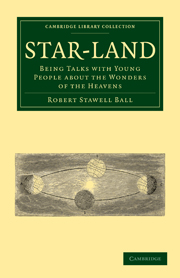CONCLUDING CHAPTER: HOW TO NAME THE STARS
Published online by Cambridge University Press: 01 June 2011
Summary
Everyone who wishes to learn something about astronomy should make a determined effort to become acquainted with the principal constellations, and to find out the names of the brighter and more interesting stars. I have therefore added to Star-land this little chapter; in which I have tried to make the study of the stars so simple, that by taking advantage of a few clear nights, there ought to be no difficulty in obtaining knowledge of a few constellations.
The first step is to become familiar with the Great Bear, or Ursa Major, as astronomers more generally call the group. We begin with this, because after it has been once recognised, then you will find it quite easy to make out the other constellations and stars. It may save you some trouble if you can get someone to point out to you the Great Bear, but even without such aid, I think you will be able to make out the seven bright stars which form this remarkable group, from the figure here given (Fig. 90). Of course, the position of this constellation, as of every other in the heavens, changes with the hour of the night, and changes with the seasons of the year. About April the constellation at 11 o'clock at night is high over your head. In September at the same hour, the Great Bear is low down in the north.
- Type
- Chapter
- Information
- Star-LandBeing Talks with Young People about the Wonders of the Heavens, pp. 357 - 368Publisher: Cambridge University PressPrint publication year: 2010First published in: 1889



